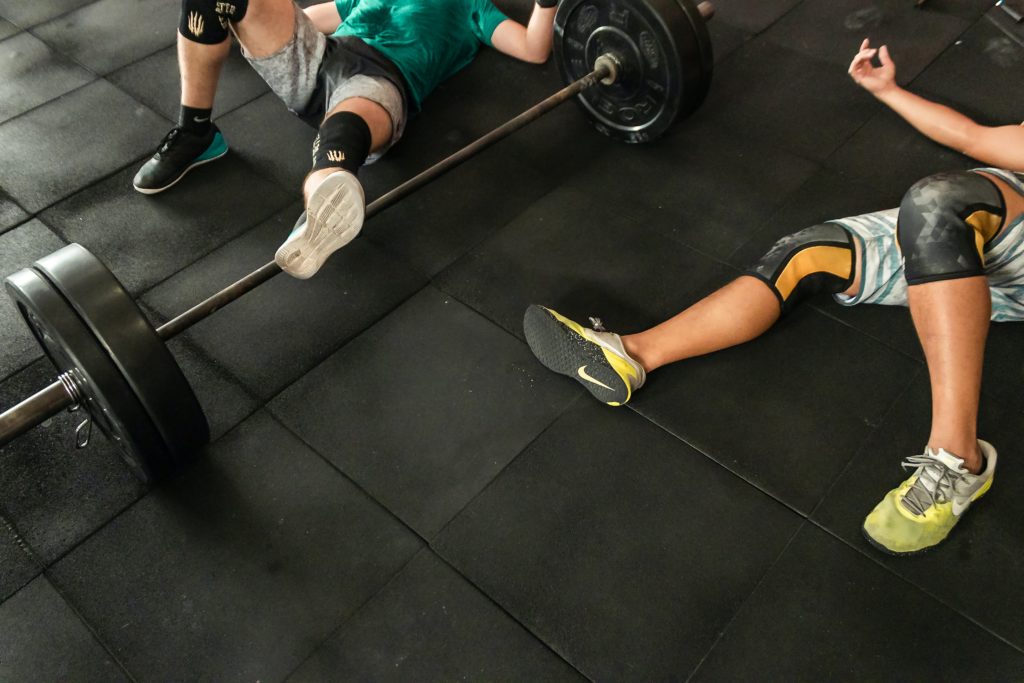Flawed logic and pseudoscience from the folks at places like Orangetheory, F45, and CrossFit led you to believe that you have to feel like you’re constantly fighting for your life while exercising. I’m sorry, but they’ve lied to you. They’re wrong. You don’t need to feel like you’re going to puke a lung or fart blood out of your ears every time you train. In fact, that’s a bad thing. (Even if the training only exhausts you and doesn’t propel lungs or blood from weird places.)

Now, I won’t say they’ve knowingly lied. The folks at the top of these organizations may be perfectly fine people that just don’t know their asshole from their elbow. But what I can tell you is that their slick marketing and intense exercise classes have played on your reward systems to make false beliefs seem real and necessary.
They’ve hoodwinked your feelings and it’s done wonders for their brand recognition and their bottom lines. They’re a lot like that really hot person you were interested in that led you on only to break your heart…and leave you scratching…a lot…between your thighs.
But as it goes with effectively choosing a significant other, so it goes with smart training decisions. Sometimes you must ignore how “excited” you are, say fuck your feelings, and make a smart, informed decision.
Informed is the operative word.
So, read on to get the information necessary to unbind your feelings from bad training ideas and make smarter training decisions.
Building Raw Materials
A few weeks back, we asked our clients what burning questions they had about training. One of our folks asked,
“What gives with the Endurance classes? If I keep my heart rate down (or stay in the blue while using Morpheus) it feels like I’m barely working out.”
(Our Endurance classes are based on heart rate training in zone 2 and low zone 3 to build the raw materials of endurance.)
Feels.
There’s that dang word again.
Effective training sessions do what they need to do for your body.
Sometimes they feel easy. Sometimes they feel hard.
And sometimes yet, they’re middling between “oops, I crapped my pants” and “my, my this is a lovely stroll.”
You can’t dial in on one feeling and expect that to be your best training metric. Different types of training do different things to construct your fitness.
Think about your body as if it were a house. When you live in your house, and there are no problems, you don’t see all of the constituent parts. The plumbing just works. The walls stand firm. Each room serves its purpose.

But all of the pieces of your house were built individually. The foundation was laid; the frame was erected; the wiring and plumbing snaked through the entire building. Specialists worked on their given piece of the puzzle. The plumber plumbed. The roofer roofed. And so on until your house was completed. Training works the same way.
Let’s use the endurance question as an illustration.
We train in zone 2 and low zone 3 during Endurance class because we build valuable fitness machinery in those zones. Our heart beats at the rate necessary for improving cardiac output, or the amount of blood pumped out with each beat. That means more oxygen and nutrients are sent to working muscles.
Mitochondria are built. If you watched The Magic School Bus, you know that mitochondria are the powerhouse of the cell. That means that your muscles get better at utilizing oxygen and nutrients to aerobically produce energy.
Zone 2 and low zone 3 training also improves our vascular network by increasing capillary density. That means there is more surface area for oxygen and nutrients to be transported to working muscles.
Now, this important construction won’t happen if our heart rate gets too high. And if you chase sweat, burn, and intense feeling of a “hard” workout, your heart rate will certainly get too high.
Consider this illustration in reverse.
Let’s say that you’re a runner and that running is all you do because you love the runner’s high. So, you chase it all the time at the expense of all other “house building.” We’ll even posit that you do most of your running in the endurance-building heart rate zones.
All’s hunky-dory, right? Maybe. In this scenario, you’re still dependent on your feelings’ whims. You’ll also have a shoddy house.
Remember, you need a foundation, walls, plumbing, etc. You can’t build only one part of the house and expect it to stand for a significant measure. Your “house” needs movement capacity, strength, power, and endurance. You might accentuate one part of the house to meet a performance goal. For example, running a marathon. Sometimes we specialize to achieve something. But you can only do that effectively over the long term if you start by building a stable house. Otherwise, the house falls apart before it should. And, in the short term, you don’t perform as well as you could.
Start by deciding what it is you want your body to do for you. That means setting short- and long-term goals. Let’s say that the short-term goal is to finish a marathon. And that your long-term goal is to be physically able to dance at your great-grandchild’s wedding. Each outcome requires that you adopt a set of behaviors. If you want to finish a marathon, you have to run. If you want to dance at your great-grandchild’s wedding, you have to build a strong, durable body while also caring for your health on a broader scale.
Here’s the kicker for both of these scenarios: if you only follow your feelings, you won’t reach your goal.
If you skip your strength work because you only feel like running, your body’s durability will go to shit. You’ll increase your likelihood of injury while limiting your performance.
If you only do brutal workouts because you’re chasing that feeling you’ll miss out on developing your aerobic fitness, one of the most important aspects of health and longevity.
You’re building a house, a base-level of fitness that promotes your physical health and allows you to specialize in the short-term to reach specific goals. Starting with that objectivity gives you the means to separate yourself one degree from your feelings. That separation gives you cause to act per your goals instead of chasing an emotion. Do the thing that gives your body what it needs, not the thing that scratches your emotional itch.
Exercise Porn
Cocaine, booze, porn, and hard workouts have something in common. No, it’s not that they all run amok in CrossFit gyms or that OrangeTheory constructed their business model to attack the brain like a hardcore porno. (Unless, maybe both are true?) It’s that they all hit your reward system hard. They cause huge dopamine spikes followed by huge dopamine crashes. The spikes feel really good. The crashes don’t. So, what do we do during the crash after a big spike? We hunt for more dopamine. That means more coke, more booze, more porn, or more hard workouts.
Consider this in terms of the common on-the-wagon-off-the-wagon exercise cycle.
A person gets a big hit of motivation and they start training hard four or five days per week. They get big dopamine hits after each workout. Then, there’s a crash. So, they work out hard again to get the same fix. Then the same crash. Soon, the pain of the crash, and the soreness of working out, defeat the feel-good spikes and the person quits. The cycle begins again the next year. All because they chased a feeling.
But let’s say that you stay on the wagon and kept training hard all the time. What happens then?
If you treat exercise like porn you end up with a similar outcome. You’re excited in the moment, and maybe shortly after. But then you come to the realization that all you did was have sex with yourself.
Then what happens for the rest of your life? Let’s say you get through your hard training and then your dopamine crashes. Can you be as present with your family? Can you do as good of a job at work? Likely not. Now, perpetuate that cycle over and over again. Will behaving that way evolve you into the person you want to become?
Here’s Dr. Huberman on the Jocko Podcast with a deeper explanation of how this works:
Then Comes the Plateau
Beyond dopamine and rewards, it’s important to note that brutal workouts at gyms like OrangeTheory, F45, and CrossFit train your body for incredibly short-term adaptations. That’s why so many people plateau hard at these gyms. And that’s why we don’t train that way.
The high-intensity workouts that they market mostly train the anaerobic energy system–specifically the anaerobic-lactic system. Anaerobic-lactic adaptations last only for a couple of weeks, and they require an incredible amount of intensity to maintain. But that intensity is untenable. So, folks make great initial progress with constant high-intensity training, and then they experience a big stall because they can’t push the adaptation any further. And because they can no longer recover from the workouts. (Plus that dopamine crash.)

Shoddy, shoddy house construction.
If, however, a person has a developed aerobic system, and has built appreciable strength that allows them to manage intensity, they could recover from high-intensity workouts. But the Halloween gym, the letter-number gym, and fuckin’ CrossFit don’t address this reality.
The truth is that we all need a minuscule amount of high-intensity training to make progress. One workout per week, and often times less than that, is usually enough unless you’re in a specific training phase that requires anaerobic-lactic development.
Do It Anyway
Consistency is the most important variable for producing and maintaining, long-term training results. Knowing that, you have to ask yourself, what training allows me to be consistent over the long haul?
Exercise porn quickly burns you out.
It also builds a wobbly house.
But focusing on short-term and long-term goals while behaving in ways commensurate with achieving them, regardless of how you feel, does the deed.
Sometimes that means doing hard, uncomfortable shit that you don’t want to do. Sometimes it means tapping the breaks and doing your zone 2 work because it’s the right thing to do.
No matter the specific instance, examine what you value and what you want to achieve and act, whether or not your emotions are telling you to do that thing.
A little while before this writing, a Beyond Strength client approached me when I was sitting at the front desk. She said, “Todd, what do you do when you just don’t really feel like working out?”
I said, “I do it anyway.”
That wasn’t the answer she was looking for. She wanted a rah-rah speech. But it was the honest answer and the one that we all need.
It was an easy answer for me to give because I know my values; I know my short-term goals, and I know my long-term goals. Clarity safeguards me against my feelings.
You need the same clarity. And you need to continue learning about how training works. That way you can do the thing you need to do when it needs to be done–whether it’s a “boring” cardio workout or putting the hammer down on some hot, nasty conditioning. You’ll know when to press the gas and when to press the brake.
And no matter what your emotions tell you, you’ll be able to do the thing you need to do.
Pay Attention, But Don’t Chase
Chasing a feeling is not the best course of exercise action. But we have to listen to how we’re feeling. The latter prevents the former. Let’s chat about it in hypothetical form.
You wake up one day and your recovery is deep into the shithouse. It feels like someone lit you on fire and put you out with a pitch fork. Trouble is, you have a high-intensity workout planned for that day. And you’d really like that feeling you get during and just after that ass-kicker workout.
What should you do?
Pay attention to how your body is feeling and ignore the feeling that you want to chase.
It doesn’t mean bailing on training. But it does mean dialing back the intensity so you don’t put yourself further into the tank. There is a difference between acknowledging how you’re currently feeling and ignoring what your body is telling you because you want to chase another feeling. Do the right thing for your body at the right time. This is the crux of consistency.
Pay attention, but don’t chase.
Fuck Your Feelings (Kind of)
Just because you’ve been sold some bad goods doesn’t mean that you need to use them. Remember that you’re building a house, and that a stable one has well-built but independent components that work together. High-intensity exercise porn will only lead you to the dark side. And you need to do what you need to do in accordance with your goals. That means paying attention to how you’re feeling but not chasing feelings. And all of this sums into the most important training variable–consistency.
